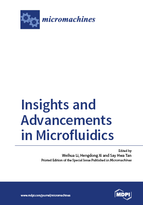Insights and Advancements in Microfluidics
A special issue of Micromachines (ISSN 2072-666X).
Deadline for manuscript submissions: closed (15 January 2017) | Viewed by 164335
Special Issue Editors
Interests: microfluidics and nanofluidics; lab on a chip; smart materials and structures; rheology; intelligent mechatronics
Interests: turbulence; microfluidics; convection; polymeric drag reduction and polymer additives
Interests: microfluidics and nanofluidics; lab-on-a-chip; droplets; emulsions; bubbles; electrohydrodynamic; intelligent systems; smart microdevices; liquid metals
Special Issues, Collections and Topics in MDPI journals
Special Issue Information
Dear Colleagues,
Microfluidics has developed rapidly over the past three decades. Relentless diagnostic, medical and chemical applications have been demonstrated in various applications, plateforms and tools. Have microfluidics realized its full potential? Or is it only a leveraging academic tool? In this Special Issue, we focus on both insights and advancements in microfluidics. We invite emerging investigators and pioneers to contribute commentaries, perspectives and insightful reviews on related topics. The various insights from esteemed colleagues will be collated. We will also discuss technological breakthrough of original works in both short communications and full papers. The main idea is to stimulate the community and to provide an unique collection of insightful papers. We will also cover various topics ranging from 3D printing, paper-based microfludics to conventional polymer-based microfluidics which contributes to the technological advancements.
Prof. Dr. Weihua Li
Prof. Dr. Hengdong Xi
Dr. Say Hwa Tan
Guest Editors
Manuscript Submission Information
Manuscripts should be submitted online at www.mdpi.com by registering and logging in to this website. Once you are registered, click here to go to the submission form. Manuscripts can be submitted until the deadline. All submissions that pass pre-check are peer-reviewed. Accepted papers will be published continuously in the journal (as soon as accepted) and will be listed together on the special issue website. Research articles, review articles as well as short communications are invited. For planned papers, a title and short abstract (about 100 words) can be sent to the Editorial Office for announcement on this website.
Submitted manuscripts should not have been published previously, nor be under consideration for publication elsewhere (except conference proceedings papers). All manuscripts are thoroughly refereed through a single-blind peer-review process. A guide for authors and other relevant information for submission of manuscripts is available on the Instructions for Authors page. Micromachines is an international peer-reviewed open access monthly journal published by MDPI.
Please visit the Instructions for Authors page before submitting a manuscript. The Article Processing Charge (APC) for publication in this open access journal is 2600 CHF (Swiss Francs). Submitted papers should be well formatted and use good English. Authors may use MDPI's English editing service prior to publication or during author revisions.
Keywords
- Insights
- Advancement
- Perspective
- Microfluidics
- Lab on a chip
- Development








